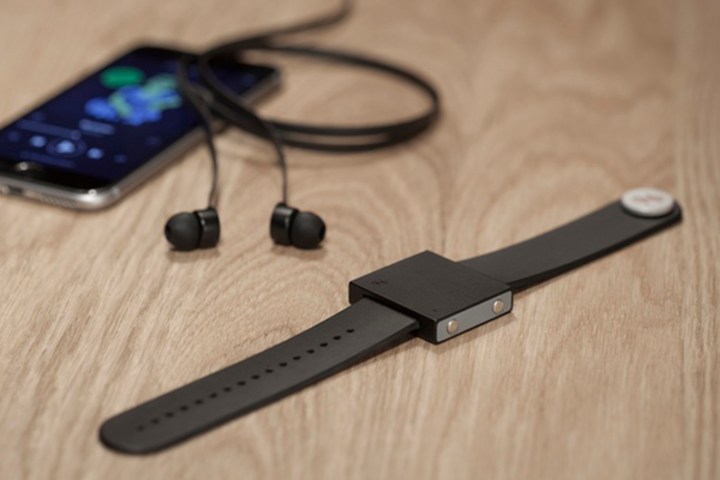
The Basslet package consists of a low-frequency (10-250Hz) subwoofer bracelet and a “sender” that connects your headphones to the device you’re playing audio from. The sender picks up the low-frequency signals and communicates with the bracelet, which embodies the beat, vibrates, and sends that haptic feedback up your arm, “so you can literally feel the music,” the company writes on its Kickstarter page.
I stopped by the Basslet’s Berlin office to test the product and — even though it sounds like a gimmicky idea derived from a convenient portmanteau — it’s actually pretty impressive. It fits more like a watch than a bracelet, and it’s comfortable but noticeable. For the first few minutes, I was well-aware of the little box on my wrist that pulsed to the rhythm and intensity of the respective tracks I was listening to.
Then a funny thing happened: I kind of forgot the Basslet was there. It was about a minute into Kendrick Lamar’s Bitch, Don’t Kill My Vibe that the sonic and the haptic sensations blended together, like that full-body feeling you get when you simultaneously hear and feel the music at a club. During my demo, the sensations never totally unified and the device was ever-present on my wrist but, like with a watch, with time that may have subsided.
The team has a playlist to showcase the Basslet’s range. With tracks like SBTRKT’s Wildfire, Lorde’s Royals, and Patti Smith’s rendition of Smells Like Teen Spirit, bass suits some of the songs better than others. Still, the haptic feedback gave each listening experience new character.
It’s fitting that the Basslet’s birthplace is Berlin, the techno capital of the world, but the device wasn’t initially inspired by four-on-the-floor beats, droning bass, and kick drums. The Basslet’s creator, Daniel Büttner, is a bass player — the instrumental kind — and he told Digital Trends he’s always had an affinity for that tactile relationship with music.
“When you’re out at a live concert around town, you can really experience the music through how it sounds and how it feels. But then when you go home and play the same track from your speaker or headphones, it just isn’t the same. It doesn’t feel the same,” he said. “We don’t think we can recreate that live experience, but that’s out inspiration.”
Thus began his journey to bring the Basslet to market. It’s been long and often complicated, Büttner said, but the immediate success of the Kickstarter campaign is validation that they’re on to something. The campaign launched on June 21 with a goal of 50,000 euros ($55,250) and each device selling for around $150. Ten days later, at the time this article was published, they’ve raised over 280,000 euros ($310,000) pledged.



